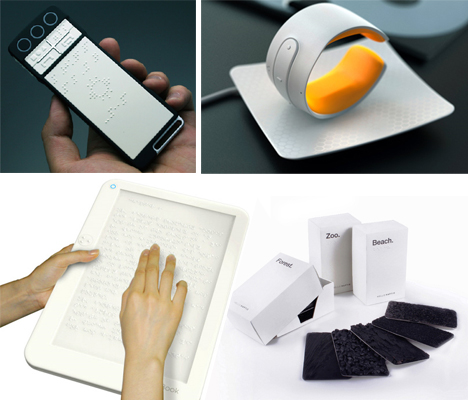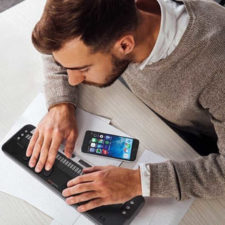Braille Displays and Notetakers: Must-Have Tools for Learning and Work
Wiki Article
Discover Cutting-edge Devices Developed for the Aesthetically Impaired
The development of innovative devices for the aesthetically damaged represents a considerable development in accessibility and self-reliance. Technologies such as smart glasses with AI capacities and mobile applications developed to give auditory summaries are reshaping everyday experiences for individuals. Additionally, wearable gadgets that employ haptic responses boost ecological recognition, while modern Braille innovations provide brand-new means to engage with text. As these devices remain to progress, their effect on the lives of those with aesthetic disabilities elevates essential inquiries regarding the future of inclusivity and freedom in various aspects of life. What lies ahead in this technological landscape?Smart Glasses for Navigating

Smart glasses created for navigating are reinventing the way visually impaired people communicate with their setting. These advanced gadgets make use of a combination of electronic camera technology, expert system, and auditory responses to give real-time information about surroundings. By using challenge discovery systems, smart glasses can alert individuals to potential hazards, making it possible for safer flexibility in both unfamiliar and acquainted settings.
The integration of GPS innovation additionally enhances navigation capacities, enabling users to obtain auditory directions as they move. This hands-free technique not just promotes self-reliance yet also encourages visually damaged individuals to navigate city landscapes with increased confidence. Additionally, many clever glasses are equipped with features that determine sites and road signs, supplying contextual info that boosts the customer experience.
In addition, the advancement of these devices is consistently advancing, with firms functioning to boost the precision of things recognition and expand the variety of navigational functions. As smart glasses become more accessible and inexpensive, they hold the potential to substantially transform every day life for visually impaired customers. Ultimately, these innovative tools represent a vital step towards inclusivity, offering enhanced flexibility and a higher feeling of freedom for individuals browsing the world around them.

Mobile Apps for Daily Living
How can mobile applications enhance the day-to-days live of aesthetically impaired people? Mobile applications are revolutionizing the way visually impaired individuals navigate their atmospheres, take care of daily tasks, and gain access to details. These applications provide crucial assistance with various functionalities, promoting freedom and boosting lifestyle.Numerous ingenious mobile apps are developed especially for day-to-day living. Apps like Be My Eyes link aesthetically impaired users with sighted volunteers via video clip calls, permitting them to obtain real-time support with tasks such as reading labels or navigating unknown areas. Similarly, Seeing AI, developed by Microsoft, makes use of expert system to describe surroundings, reviewed text, and determine objects, successfully changing a smartphone into a powerful tool for daily aid.
In addition, navigation applications customized for the aesthetically impaired, such as Aira and BlindSquare, use audio-based directions and ecological info, allowing customers to traverse their surroundings securely and confidently. Past navigation and prompt assistance, mobile apps additionally support company and job monitoring, with attributes that aid individuals set reminders, develop to-do checklists, and track visits. In recap, mobile applications function as important resources, encouraging visually impaired individuals to lead even more independent and satisfying lives.
Wearable Technologies for Help
Empowerment with modern technology is increasingly apparent in the realm of wearable gadgets developed to help visually damaged individuals. These ingenious devices incorporate flawlessly into day-to-day live, improving navigation and giving important feedback to individuals. Clever glasses outfitted with video cameras can acknowledge faces and review message aloud, permitting individuals to connect even more confidently in expert and social settings.One more notable advancement is using haptic responses systems in wearable devices. These systems make use of vibrations or other responsive signals to share info regarding you could check here the user's setting, such as challenges or changes in surface, enhancing mobility and safety and security. Wearable technologies additionally consist of wristbands that connect to smartphones, alerting customers to notifications via subtle vibrations, hence improving connectivity without dependence on visual signs.
As these technologies proceed to evolve, they are not only improving freedom for visually impaired individuals but additionally promoting a higher feeling of addition in culture. By connecting the space in between challenges faced in daily living and the potential for autonomy, wearable innovations act as critical tools in the quest for equality and empowerment for those with visual problems.
Audio Description Tools
Audio summary devices play an important function in improving accessibility for aesthetically damaged individuals, offering them with the capacity to involve with aesthetic media. Speech-to-text devices for low vision. These tools offer narrated summaries of crucial aesthetic elements in movies, television shows, and live efficiencies, making sure that individuals can completely comprehend the context and emotions communicated through visualsAudio summary can be incorporated into numerous platforms, including streaming solutions, movie theater testings, and live cinema. Many popular streaming services currently consist of audio summary as an accessibility feature, enabling viewers to choose it quickly. Along with traditional media, specialized apps additionally exist, offering audio descriptions for art exhibitions, galleries, and various other social events.
The efficiency of audio summary depends upon the ability of the narrators, who must convey aesthetic details succinctly without taking away from the original audio. Technologies in this area are also leading the way for more tailored experiences, where customers can readjust the level of information and pacing according to their preferences.
Braille Innovations and Instruments
Braille tools and developments have actually dramatically changed the way aesthetically damaged people connect with text and info. Modern innovations have led to the growth of flexible devices that enhance proficiency and self-reliance amongst users.
Moreover, mobile Braille notetakers combine typical Braille input with modern-day performances, helping with note-taking, organizing, and paper editing on the move. Voice-activated assistive devices. These portable devices usually feature text-to-speech capacities, linking the void in between Braille and auditory information
Furthermore, cutting-edge Braille printers have arised, Go Here permitting customers to create Braille labels, documents, and academic products successfully. This ease of access cultivates better involvement in specialist and academic settings, ultimately advertising inclusivity.
In addition, Going Here study into wise Braille technologies remains to expand. Gadgets that integrate synthetic knowledge are being explored to offer real-time navigating aid and contextual information, improving the customer experience in varied settings. Generally, these advancements show a commitment to encouraging visually damaged individuals via technology, ensuring they can conveniently gain access to and engage with the globe around them.

Conclusion
The development of ingenious tools for the visually impaired substantially boosts self-reliance and quality of life. These technologies not only foster greater incorporation however additionally promote autonomy in day-to-day activities, eventually contributing to a much more accessible and equitable culture for aesthetically impaired individuals.As wise glasses become a lot more budget-friendly and obtainable, they hold the potential to dramatically change everyday life for aesthetically impaired users. Mobile applications are reinventing the method aesthetically impaired individuals browse their environments, manage day-to-day tasks, and access details. Apps like Be My Eyes link aesthetically damaged customers with sighted volunteers using video telephone calls, enabling them to obtain real-time support with tasks such as checking out tags or navigating unknown areas.In addition, navigation apps customized for the visually damaged, such as Aira and BlindSquare, provide audio-based directions and ecological information, making it possible for customers to traverse their environments securely and confidently.The innovation of cutting-edge devices for the aesthetically damaged substantially boosts freedom and top quality of life.
Report this wiki page